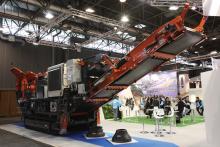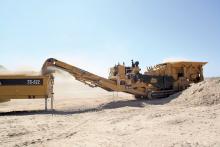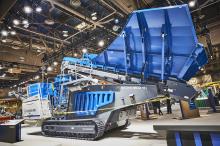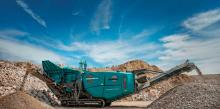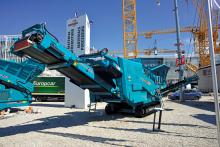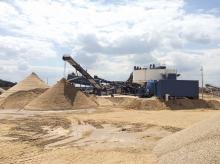The crushing and screening sector has seen a flurry of new model launches in recent months, with a series of new equipment introductions - Mike Woof writes. Crushing and screening systems play a vital role in the overall cost effectiveness of a quarrying operation. Ensuring that a quarry runs efficiently relies heavily on the appropriateness of the entire crushing and screening set-up for the material input, the output grades and the compatibility of each separate unit. Mobility has been a key issue in rece
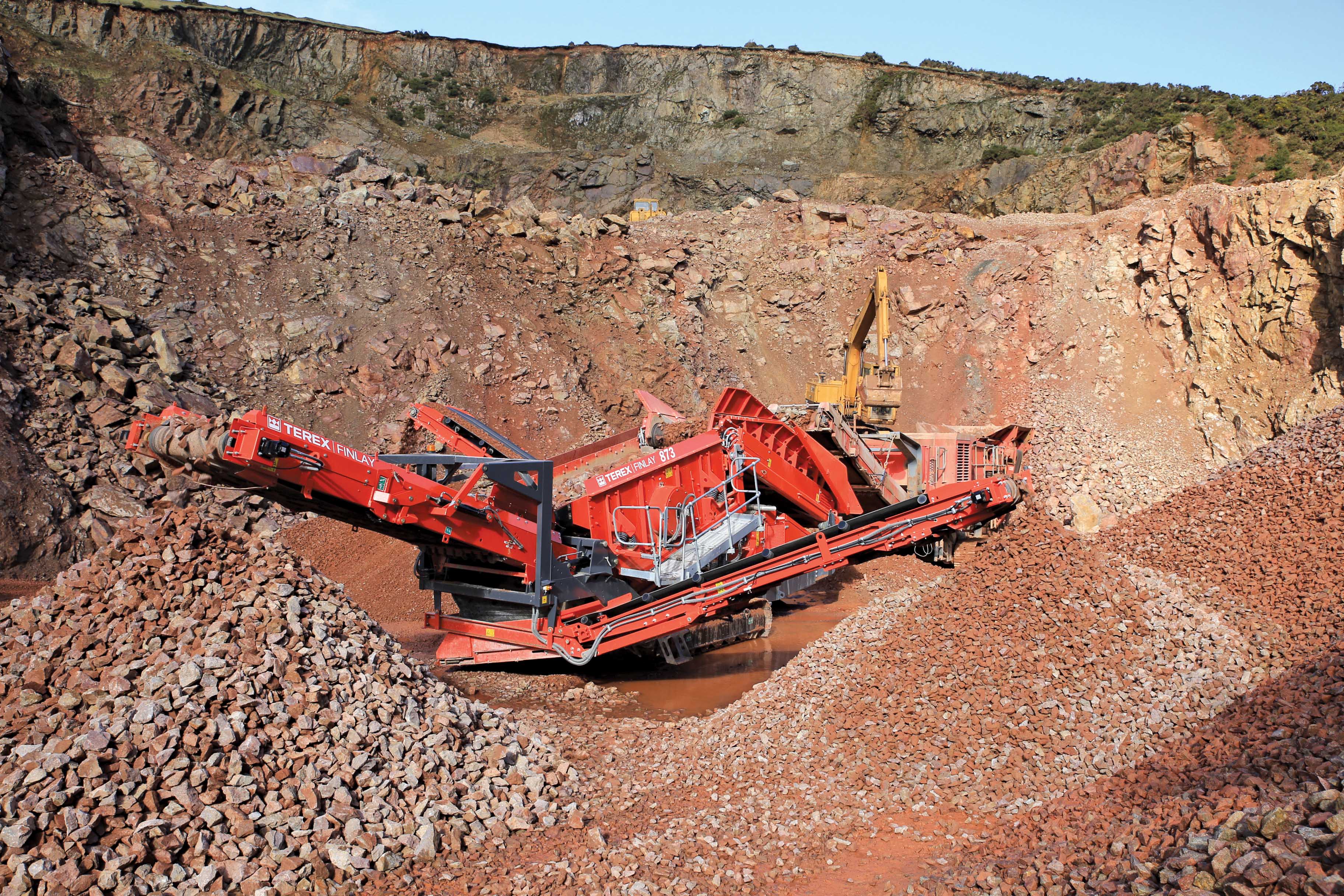
The new 873 screen from Terex Finlay shares many features with the 673 launched last year
The crushing and screening sector has seen a flurry of new model launches in recent months, with a series of new equipment introductions - Mike Woof writes
Crushing and screening systems play a vital role in the overall cost effectiveness of a quarrying operation. Ensuring that a quarry runs efficiently relies heavily on the appropriateness of the entire crushing and screening set-up for the material input, the output grades and the compatibility of each separate unit. Mobility has been a key issue in recent years, with new generation proving easier to transport and set up on site. In addition, new generation washing technology also allows for higher-quality product.
The reliability of the crushing and screening circuit as well as the support available to back up each machine are equally important, as unplanned downtime can have severe financial penalties for a quarry. The latest technology with continuous monitoring of equipment performance through the Internet and remote troubleshooting has further aided reliability and productivity and made a major contribution to overall profitability.
7408 IROCK Crushers is now offering a diesel option for its Sidewinder range. The Sidewinder-15 is available with a 261kW 178 Caterpillar C-9 diesel engine that drives a 75kW generator and delivers full on-board power. The power system is an alternative to the standard electric option.
The crusher is V-belt driven and features a PT Tech clutch, decreasing power losses and increasing fuel efficiency. An optional vibrating feeder with a tipping grid can be powered by the Sidewinder through a variable frequency drive and remote control. The machine incorporates a 1.52x4.88m Cedarapids horizontal screen box with a triple-shaft design for long life. IROCK has also equipped the new Sidewinder with four hydraulic outriggers for set-up.
The machines have a closed-circuit design and a four-bar impactor, and they can produce up to four product sizes – three uniformly sorted and one oversized. A flop gate within the pant leg chute allows operators to either recirculate the crushed oversized material for further screening and crushing or divert it to be stockpiled as a 100% crushed material.
These crushers suit primary crushing in sand and gravel applications and recycled asphalt operations, or for secondary use with materials such as recycled concrete and rock. There are three sizes available, each with a three-deck horizontal screen. With screening areas of 19.5, 26.75 and 33.44m2 respectively, the Sidewinder 15, 20 and 30 can process 361, 552 and 677tonnes/hour.
The mobile crushers feature IROCK’s exclusive ROCK BOX, an innovative alternative to discharge chutes found on similar units. The ROCK BOX uses a shelf system with abrasion-resistant wear bars so that crushed material can build up and act as a wear liner to reduce maintenance needs. In addition, catwalks alongside the unit provide access to each side for ease of maintenance or screen media changes.
261 Kleemann’s Mobicone MCO 9 EVO offers high mobility and throughput. This new cone crusher is compatible with the mobile jaw crusher Mobicat MC 110 EVO, and is aimed at the contractor market. Throughput is said to be high due to the innovative crusher housing design. A continuous drive power at the crusher of 160kW is available, allowing a throughput of up to 260tonnes/hour. The machine has a direct crusher drive as well as electric drives for the conveyor belts, boosting working efficiency. An anti-spin system prevents the crusher cone from rotating, reducing wear. Weighing 30tonnes, the MCO 9 EVO is said to be easy to transport and is ready for operation again quickly. The machine can be used downstream from the firm’s Mobicat MC 110 Z EVO mobile jaw crusher to provide a steady throughput and high product quality. Both machines feature the firm’s continuous feed system (CFS), which controls the material flow of each unit individually. Connecting these control systems allows the CFS technology to exchange data, allowing the MCO 9 to govern its own conveyor unit through its crusher filling level as well as the conveyor elements of the upstream MC 110.
McCloskey’s latest J45 crusher is designed to be compact and highly mobile, while offering increased crushing throughput due to its longer jaw and revised tip angle. Other crusher features include a reversible hydrostatic drive, reversible jaw plates and twin ram wedge closed side setting (CSS)adjust. The feeder rate can be regulated either manually or automatically while the machine has a 12.8m long main conveyor as standard that is raised and lowered hydraulically and offers a large stockpiling capacity.
Weighing 50tonnes and featuring a compact design considering its throughput capacity, the J45 is said to be easy to transport. For transport, the machine is 3.4m high by 2.5m wide and 14.5m long. Power now comes from a783 Volvo Penta diesel that delivers 261kW and is Tier 4 Final compliant. The machine has been designed to make it easy to service, with direct access to hydraulics and has a modern control system that will start and stop the feeder.
The machine features the firm’s high-energy technology for its screenbox and the feeder is available with an independent pre-screen option. Another feature is the recirculation conveyor that can be specified by customers wanting to produce a crushed and screened product using a single machine.
747 Rubble Master is at present focusing on increasing its crusher rental business. The firm now offers four compact crusher models for rent, the RM 60, RM 70 GO!, RM 80 GO! and RM 100 GO!, as well as pre and final screens and various other options. The crushers can produce high-quality aggregate. The firm said it has seen an increase in demand for crusher rental as this offers a good option for short-term recycling or demolition contracts, for example. The firm is working on new compact crusher designs as well and hopes to launch these later in the year.
According to Stedman, its new Grand Slam horizontal shaft impactor offers increased working efficiency, as well as greater throughput and wear life. The impactor has an optimised internal design with an intake slope of 60° as well as a revised mill configuration, which are said to help deliver efficient throughput and a higher product quality. The design of the machine with its front opening allows quicker maintenance due to better access to the internal components. These can be changed easily when worn, lowering costly downtime while the 50mm thick wear liners offer increased wear life. The firm has reduced the number of profiles for the wear liners also, lowering the stock holding required for the customer (or dealer) and further cutting operating costs over time.
Stedman said that the crusher can deliver reduction ratios of 30:1 with a single stage. The unit can handle feed sizes of 200mm, while product sizes can be varied by changing the rotor speed as well as the spacing between the breaker bars and the apron breaker plates.
Terex Finlay is investing heavily in developing new models at present and has launched the J-1170AS jaw crusher and 1545 cone crusher, while the company said it also has a compact jaw crusher in development.
The new high-performance3501 Terex Finlay J-1170AS jaw crusher is built around the proven Terex 1100mm x 700mm jaw crusher. An important feature of this model is the on-board detachable sizing screen. Said to deliver efficient material reduction and product sizing when processing blasted rock, the J-1170AS’s jaw chamber is also available with an optional hydraulic release, a key feature for crushing construction and demolition debris. The hydraulic release option has an automatic overload protection system to prevent damage by uncrushable items in the feed material.
The machine is powered by either a Tier 3/Stage 3A Caterpillar C9 261kW or a Tier 4 Interim759 Scania DC9 70A 257kW engine. Hydrostatic transmission of the jaw chamber means that the unit can be reversed in the event of a blockage. The hydrostatic system also provides variable chamber speed to suit given applications. The crusher features hydraulic assist Chamber CSS (closed side setting) adjustment, and can be changed quickly.
The machine has a heavy-duty, variable speed vibrating grizzly feeder (VGF) with integrated pre-screen. The variable speed VGF provides continuous choke feeding of the crushing chamber and is said to optimise productivity. Material from the pre-screen can be diverted to a stock pile through the on-board by-pass conveyor, or join the crushed product on the main belt.
Its 9.6m³ hopper has hydraulically folding sides and an innovative hydraulic self-locking mechanism, said to allow quicker set-up and tear down times.
The C-1540 cone crusher meanwhile is an innovative machine featuring a dual-power system and can be driven either by its own, on-board generator or by a mains electrical supply. The firm claims that this layout helps lower maintenance and running costs for the customer, while boosting reliability.
The machine features the proven Terex 1000 cone crusher, which is powered by a direct electric drive system. Other key features include an automated system to remove tramp metal and prevent damage as well as hydraulic closed side setting (CSS) adjustment. This machine can be fitted with an optional patented pre-screen module that allows fines to be removed from the crushing chamber feed. With fines bypassing the crushing chamber, this reduces wear rates and extends machine life.
A major benefit to wear life and reliability comes from the large hopper/feeder with its automated metal detection and purge system, protecting the cone. This package reduces downtime by removing metal contaminants using a special chute.
The 5mx1.5m double deck screens can be integrated into the M2500 mobile washing plant while the 6mx1.8m version is provided as part of the M4500. The new R2500 primary screening unit also features the double deck 5mx1.5m screen, while smaller sizing screens are included on the AggMax portable logwasher. All screens within the new Infinity range are available for application in both dry and wet screening situations across a wide range of materials including aggregates, construction and demolition waste.
The firm claimed that the Infinity screen range can deliver the same acceleration as a conventional screen but with less weight. This helps lower power consumption and operating costs. The novel design of the eccentric shaft also reduces weight and power consumption, while optimising energy transfer to the material. However, special cast crossmembers provide structural stiffness and extend working life, while effective vibration isolation further optimises energy transfer to the product. Galvanised steel components are used to address corrosion concerns and durable and lightweight glass-reinforced plastic (GRP) guards are fitted that can be removed quickly when the units are stopped for maintenance.
The new 3300 Hartl Screen Plant (HSP) is said to offer high efficiency when used in natural stone processing applications. The equipment can also be used for classifying recycled materials, according to Hartl Crusher. The electro-hydraulic drive of the HSP is said to deliver more power than conventional electric drives used in other units, further increasing efficiency and throughput. Using the HSP with the latest generation conveyor belt system, the HCB 5000 further expands the range of duties. The HCB can be fed by a bucket crusher or bucket screener directly, allowing higher capacities for on-site processing.
Haver & Tyler has developed a sophisticated package for vibration analysis of the operating health of screening systems. Sensors can be fitted to major machine components and these generate data, which can be downloaded on to a tablet device. This allows the user to carry out in-depth inspections of working parameters in-house. Information on machine health can be downloaded so as to spot wear issues early on and ensure that worn components can be replaced at scheduled maintenance intervals instead of risking unplanned downtime.
2991 Powerscreen’s highly productive and transportable Warrior 600 screen is designed so that it can be containerised, reducing transport costs. The machine can also be switched quickly and easily from three-way to two-way split mode. The firm claims that its Warrior 600 screen offers high manoeuvrability and mobility and can produce almost as much material as the next machine size up, the Warrior 800. Suited to use in applications such as materials recycling or handling construction and demolition waste, the Warrior 600 benefits from a highly aggressive screenbox. This feature is said to deliver effective separation of large items from material fines in recycling tasks, such as fines and rock from overburden and blasted rock. Mesh changes are said to be easier and quicker due to the open chassis design while hydraulic folding conveyors allow good stockpiling capacity.
Terex Finlay’s 873 screen is designed to work with a primary crusher or on its own as a frontline screening machine. This versatile and adaptable machine is suitable for applications in quarrying, construction and demolition debris. It has a forward-facing, inclined modular configuration screenbox with a 3.66mm x 1.52m top deck and a 3.66mm x 1.52m bottom deck, giving a total screening area of 14.4m2. Depending on the application, hydraulic adjustment can be used to vary the angle of the screen box from 13 to 19°. The top deck can be fitted with a variety of screening media, including tines, bofor bars, punched plate and mesh. The bottom deck can be fitted with mesh or cascade fingers.
The hopper has a 7m³ capacity as standard with a drop rear door for use in conjunction with a mobile crusher. The machine is equipped with three hydraulically folding discharge conveyors, allowing for maximum stockpiling capacity and associated benefits of rapid set-up and tear down times. The banana profile and increased area of the new bottom deck are said to maximise screening of fines.
Additional features of the machine include galvanised access ladders and catwalks fitted as standard to both sides of the screen box. Hydraulic raising of the screenbox discharge end provides additional clearance for screenbox and fines transfer conveyor maintenance.
Terex Washing Systems is focusing on its new AggreSand 206 wash plant. Capable of handling up to 400tonnes/hour of material, the AggreSand 206 is suitable for all industrial, construction, recycling and mining applications.
The first AggreSand 206 wash plant has been installed in the UK at the new3180 Lafarge 2399 Tarmac site in Bedfordshire, England, where it is working alongside an AggreScrub 150. This set-up is said to allow the customer to deliver a wider product range and to a higher quality. An important part of the AggreSand concept is the novel modular design, according to the firm. Other benefits include ease of servicing and maintenance.
Mobility is maximised as the units can slot into standard containers with pre-wired and pre-plumbed componentry, isolated spray bars and a simple automated control system.
Crushing and screening systems play a vital role in the overall cost effectiveness of a quarrying operation. Ensuring that a quarry runs efficiently relies heavily on the appropriateness of the entire crushing and screening set-up for the material input, the output grades and the compatibility of each separate unit. Mobility has been a key issue in recent years, with new generation proving easier to transport and set up on site. In addition, new generation washing technology also allows for higher-quality product.
The reliability of the crushing and screening circuit as well as the support available to back up each machine are equally important, as unplanned downtime can have severe financial penalties for a quarry. The latest technology with continuous monitoring of equipment performance through the Internet and remote troubleshooting has further aided reliability and productivity and made a major contribution to overall profitability.
Crushing
The crusher is V-belt driven and features a PT Tech clutch, decreasing power losses and increasing fuel efficiency. An optional vibrating feeder with a tipping grid can be powered by the Sidewinder through a variable frequency drive and remote control. The machine incorporates a 1.52x4.88m Cedarapids horizontal screen box with a triple-shaft design for long life. IROCK has also equipped the new Sidewinder with four hydraulic outriggers for set-up.
The machines have a closed-circuit design and a four-bar impactor, and they can produce up to four product sizes – three uniformly sorted and one oversized. A flop gate within the pant leg chute allows operators to either recirculate the crushed oversized material for further screening and crushing or divert it to be stockpiled as a 100% crushed material.
These crushers suit primary crushing in sand and gravel applications and recycled asphalt operations, or for secondary use with materials such as recycled concrete and rock. There are three sizes available, each with a three-deck horizontal screen. With screening areas of 19.5, 26.75 and 33.44m2 respectively, the Sidewinder 15, 20 and 30 can process 361, 552 and 677tonnes/hour.
The mobile crushers feature IROCK’s exclusive ROCK BOX, an innovative alternative to discharge chutes found on similar units. The ROCK BOX uses a shelf system with abrasion-resistant wear bars so that crushed material can build up and act as a wear liner to reduce maintenance needs. In addition, catwalks alongside the unit provide access to each side for ease of maintenance or screen media changes.
McCloskey’s latest J45 crusher is designed to be compact and highly mobile, while offering increased crushing throughput due to its longer jaw and revised tip angle. Other crusher features include a reversible hydrostatic drive, reversible jaw plates and twin ram wedge closed side setting (CSS)adjust. The feeder rate can be regulated either manually or automatically while the machine has a 12.8m long main conveyor as standard that is raised and lowered hydraulically and offers a large stockpiling capacity.
Weighing 50tonnes and featuring a compact design considering its throughput capacity, the J45 is said to be easy to transport. For transport, the machine is 3.4m high by 2.5m wide and 14.5m long. Power now comes from a
The machine features the firm’s high-energy technology for its screenbox and the feeder is available with an independent pre-screen option. Another feature is the recirculation conveyor that can be specified by customers wanting to produce a crushed and screened product using a single machine.
According to Stedman, its new Grand Slam horizontal shaft impactor offers increased working efficiency, as well as greater throughput and wear life. The impactor has an optimised internal design with an intake slope of 60° as well as a revised mill configuration, which are said to help deliver efficient throughput and a higher product quality. The design of the machine with its front opening allows quicker maintenance due to better access to the internal components. These can be changed easily when worn, lowering costly downtime while the 50mm thick wear liners offer increased wear life. The firm has reduced the number of profiles for the wear liners also, lowering the stock holding required for the customer (or dealer) and further cutting operating costs over time.
Stedman said that the crusher can deliver reduction ratios of 30:1 with a single stage. The unit can handle feed sizes of 200mm, while product sizes can be varied by changing the rotor speed as well as the spacing between the breaker bars and the apron breaker plates.
Terex Finlay is investing heavily in developing new models at present and has launched the J-1170AS jaw crusher and 1545 cone crusher, while the company said it also has a compact jaw crusher in development.
The new high-performance
The machine is powered by either a Tier 3/Stage 3A Caterpillar C9 261kW or a Tier 4 Interim
The machine has a heavy-duty, variable speed vibrating grizzly feeder (VGF) with integrated pre-screen. The variable speed VGF provides continuous choke feeding of the crushing chamber and is said to optimise productivity. Material from the pre-screen can be diverted to a stock pile through the on-board by-pass conveyor, or join the crushed product on the main belt.
Its 9.6m³ hopper has hydraulically folding sides and an innovative hydraulic self-locking mechanism, said to allow quicker set-up and tear down times.
The C-1540 cone crusher meanwhile is an innovative machine featuring a dual-power system and can be driven either by its own, on-board generator or by a mains electrical supply. The firm claims that this layout helps lower maintenance and running costs for the customer, while boosting reliability.
The machine features the proven Terex 1000 cone crusher, which is powered by a direct electric drive system. Other key features include an automated system to remove tramp metal and prevent damage as well as hydraulic closed side setting (CSS) adjustment. This machine can be fitted with an optional patented pre-screen module that allows fines to be removed from the crushing chamber feed. With fines bypassing the crushing chamber, this reduces wear rates and extends machine life.
A major benefit to wear life and reliability comes from the large hopper/feeder with its automated metal detection and purge system, protecting the cone. This package reduces downtime by removing metal contaminants using a special chute.
Screening
CDE launched its Infinity screening range after acquiring a global patent for the novel design of the screen side walls. The Infinity range includes double and triple deck screens in 5mx1.5m and 6mx1.8m configurations and the patented side wall construction has also been introduced to the new range of dewatering screens now available from CDE. The Infinity screens are available as stand-alone screenboxes as well as being integrated into the firm’s modular plants. The design for which the patent was granted allows for increased thickness of the screen sidewalls, while reducing weight. The new range is also designed without welds in the sidewalls, while wear protection at each impact point or transfer point helps maximise life. Ease of maintenance is ensured due to the 750mm spacing between the screen decks.The 5mx1.5m double deck screens can be integrated into the M2500 mobile washing plant while the 6mx1.8m version is provided as part of the M4500. The new R2500 primary screening unit also features the double deck 5mx1.5m screen, while smaller sizing screens are included on the AggMax portable logwasher. All screens within the new Infinity range are available for application in both dry and wet screening situations across a wide range of materials including aggregates, construction and demolition waste.
The firm claimed that the Infinity screen range can deliver the same acceleration as a conventional screen but with less weight. This helps lower power consumption and operating costs. The novel design of the eccentric shaft also reduces weight and power consumption, while optimising energy transfer to the material. However, special cast crossmembers provide structural stiffness and extend working life, while effective vibration isolation further optimises energy transfer to the product. Galvanised steel components are used to address corrosion concerns and durable and lightweight glass-reinforced plastic (GRP) guards are fitted that can be removed quickly when the units are stopped for maintenance.
The new 3300 Hartl Screen Plant (HSP) is said to offer high efficiency when used in natural stone processing applications. The equipment can also be used for classifying recycled materials, according to Hartl Crusher. The electro-hydraulic drive of the HSP is said to deliver more power than conventional electric drives used in other units, further increasing efficiency and throughput. Using the HSP with the latest generation conveyor belt system, the HCB 5000 further expands the range of duties. The HCB can be fed by a bucket crusher or bucket screener directly, allowing higher capacities for on-site processing.
Haver & Tyler has developed a sophisticated package for vibration analysis of the operating health of screening systems. Sensors can be fitted to major machine components and these generate data, which can be downloaded on to a tablet device. This allows the user to carry out in-depth inspections of working parameters in-house. Information on machine health can be downloaded so as to spot wear issues early on and ensure that worn components can be replaced at scheduled maintenance intervals instead of risking unplanned downtime.
Terex Finlay’s 873 screen is designed to work with a primary crusher or on its own as a frontline screening machine. This versatile and adaptable machine is suitable for applications in quarrying, construction and demolition debris. It has a forward-facing, inclined modular configuration screenbox with a 3.66mm x 1.52m top deck and a 3.66mm x 1.52m bottom deck, giving a total screening area of 14.4m2. Depending on the application, hydraulic adjustment can be used to vary the angle of the screen box from 13 to 19°. The top deck can be fitted with a variety of screening media, including tines, bofor bars, punched plate and mesh. The bottom deck can be fitted with mesh or cascade fingers.
The hopper has a 7m³ capacity as standard with a drop rear door for use in conjunction with a mobile crusher. The machine is equipped with three hydraulically folding discharge conveyors, allowing for maximum stockpiling capacity and associated benefits of rapid set-up and tear down times. The banana profile and increased area of the new bottom deck are said to maximise screening of fines.
Additional features of the machine include galvanised access ladders and catwalks fitted as standard to both sides of the screen box. Hydraulic raising of the screenbox discharge end provides additional clearance for screenbox and fines transfer conveyor maintenance.
Washing
Haver & Tyler is focusing on increasing awareness of its novel hydrocleaner for aggregates washing. This system features a drum lined with polythene and uses turbulence to clean aggregates. Cleaned material exits the drum through a discharge belt into a rinse screen and the firm offers different versions with capacities of 180tonnes/hour and 360tonnes/hour. The compact design allows the hydrocleaner to be installed in tight spaces alongside existing equipment.Terex Washing Systems is focusing on its new AggreSand 206 wash plant. Capable of handling up to 400tonnes/hour of material, the AggreSand 206 is suitable for all industrial, construction, recycling and mining applications.
The first AggreSand 206 wash plant has been installed in the UK at the new
Mobility is maximised as the units can slot into standard containers with pre-wired and pre-plumbed componentry, isolated spray bars and a simple automated control system.

